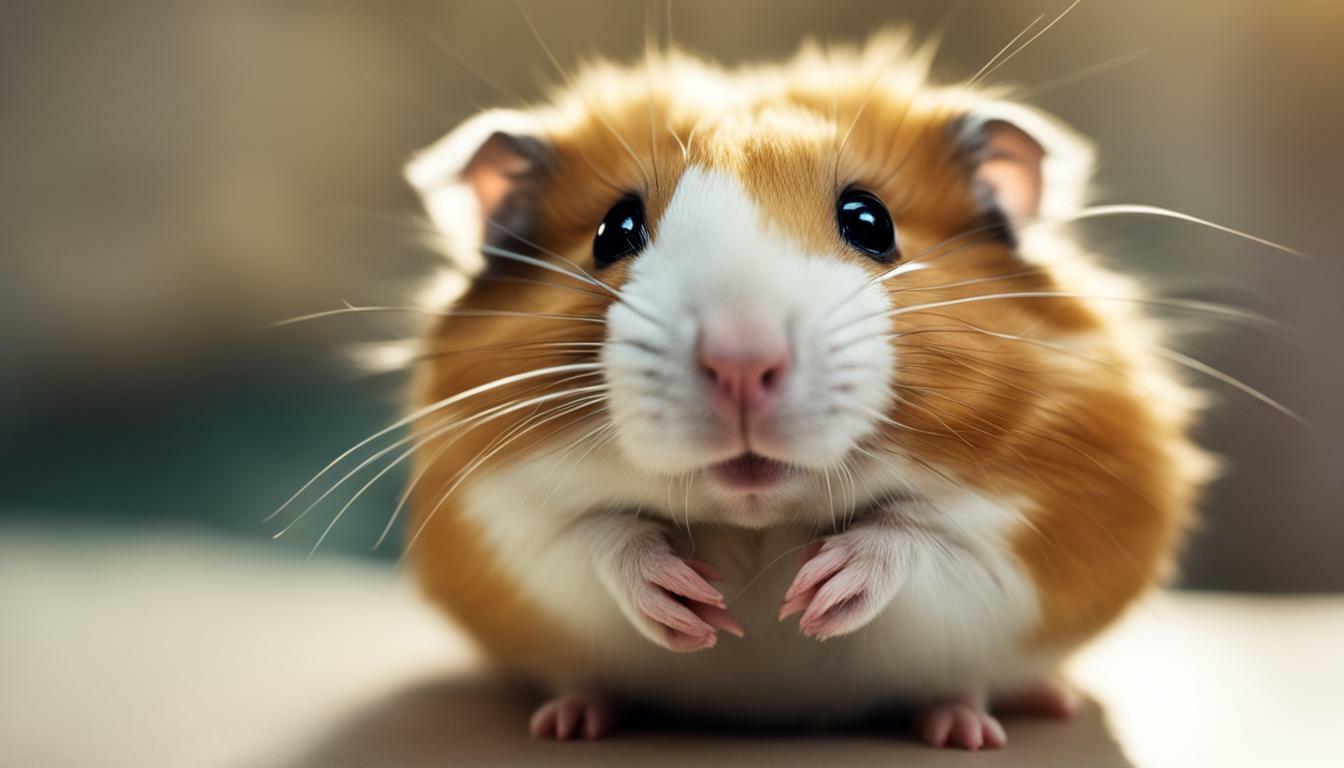If you’ve noticed that your hamster is breathing hard and struggling to catch its breath, it’s important to understand the possible reasons behind this respiratory distress.
Key Takeaways:
- Hamsters can breathe heavily and rapidly for various reasons, including respiratory infections, allergies, tumors, stress, and overheating.
- Respiratory infections and allergies are common causes of labored breathing in hamsters, which can lead to more serious conditions if left untreated.
- Environmental factors such as temperature fluctuations and drafts can also affect a hamster’s breathing.
- Monitoring for signs of heavy breathing, like wheezing, sneezing, and discharge, is crucial for detecting respiratory distress in hamsters.
- Seeking veterinary assistance is advisable if a hamster’s breathing remains consistently heavy or worsens, as respiratory infections can be serious.
Factual data: Hamsters can breathe heavily and rapidly for various reasons, including respiratory infections, allergies, tumors, stress, and overheating. They are prone to respiratory illnesses, which can lead to pneumonia if left untreated. Hamsters can also be affected by environmental factors such as temperature fluctuations and drafts. It’s important to monitor hamsters for signs of heavy breathing, such as wheezing, sneezing, and discharge from the nose or eyes. If a hamster’s breathing is consistently heavy or their condition worsens, it’s advisable to seek veterinary assistance as respiratory infections can be serious. Taking preventive measures, like providing a suitable environment, avoiding exposure to sick humans, and regular vet check-ups, can help ensure the best possible health for hamsters.
Respiratory Infections and Allergies
Respiratory infections and allergies are common culprits when it comes to hamsters experiencing breathing difficulties. These conditions can significantly impact their respiratory system, leading to labored breathing and distress. It’s crucial to be aware of the signs of respiratory distress in your hamster, such as wheezing, sneezing, and discharge from the nose or eyes.
Hamsters are prone to respiratory illnesses and can develop serious complications like pneumonia if left untreated. Therefore, it’s essential to promptly address any breathing problems your hamster may be experiencing. If your hamster’s breathing is consistently heavy or their condition worsens, it is advisable to seek veterinary assistance.
To reduce the risk of respiratory infections and allergies in your hamster, it is recommended to provide a clean and suitable environment. Avoid exposing your hamster to extreme temperature fluctuations and drafts, as these can exacerbate breathing difficulties. Regular cage cleaning and appropriate bedding can also help maintain a healthy respiratory system for your pet.
Preventing Respiratory Issues
Preventive measures play a crucial role in ensuring the overall well-being of your hamster. Along with maintaining a suitable environment, it’s important to limit exposure to sick humans, as respiratory infections can easily spread from humans to animals. Additionally, scheduling regular vet check-ups can help identify any underlying health issues and address them before they become serious.
| Takeaway Points: |
|---|
| Respiratory infections and allergies can cause breathing difficulties in hamsters. |
| Signs of respiratory distress include wheezing, sneezing, and discharge from the nose or eyes. |
| Prompt veterinary assistance is necessary for consistent heavy breathing or worsening condition. |
| To prevent respiratory issues, provide a clean environment and avoid temperature fluctuations. |
| Limit exposure to sick humans and schedule regular vet check-ups for preventive care. |
Tumors and Other Health Issues
In some cases, tumors or other underlying health issues can cause a hamster to wheeze, gasp, or pant heavily. These conditions can lead to respiratory distress and should not be ignored. Tumors can develop in various parts of a hamster’s body, including the lungs and airways, causing breathing difficulties. Other health issues such as heart disease or fluid accumulation in the chest can also contribute to heavy breathing in hamsters.
If you notice your hamster exhibiting these symptoms, it is crucial to seek veterinary assistance promptly. A veterinarian will be able to perform a thorough examination and diagnosis to determine the underlying cause of your hamster’s breathing difficulties. Treatment options may include surgery to remove tumors, medication to manage heart disease, or drainage of fluid from the chest.
| Signs of Tumors or Other Health Issues: | What to Do: |
|---|---|
| Wheezing or gasping | Contact a veterinarian for an examination and diagnosis |
| Panting heavily | Follow the veterinarian’s recommended treatment plan |
| Loss of appetite or weight | Provide a comfortable and quiet environment for your hamster |
Regular veterinary check-ups are essential for early detection of tumors or other health issues in your hamster. Your veterinarian can perform routine examinations and screenings to catch any problems before they become severe. Additionally, maintaining a clean and suitable environment for your pet, along with providing a balanced diet and regular exercise, can contribute to their overall well-being and minimize the risk of respiratory difficulties.
Environmental Factors and Hamster Breathing Problems
Environmental factors can play a significant role in hamster breathing problems, causing them to pant heavily or struggle to breathe. It is important to create a suitable and comfortable environment for your pet to minimize the risk of respiratory distress. Let’s explore some key environmental factors that can affect hamsters’ respiratory health.
Temperature and Humidity
Hamsters are sensitive to temperature fluctuations and high humidity levels. Extreme heat can lead to overheating and difficulty breathing, while cold temperatures can cause respiratory distress. It is crucial to maintain a consistent, comfortable temperature in your hamster’s habitat. Avoid placing their enclosure near drafty areas or direct sunlight. Additionally, ensure proper ventilation to prevent stagnant air and excessive humidity, as this can contribute to respiratory problems.
Bedding and Substrate
The type of bedding or substrate you use in your hamster’s cage can also have an impact on their respiratory health. Avoid using dusty or aromatic beddings that can irritate their delicate respiratory system. Opt for low-dust options such as paper-based or aspen bedding. Regularly clean and replace the bedding to prevent the buildup of ammonia and other harmful substances that can affect your hamster’s breathing.
Avoid Exposure to Irritants
Irritants in the environment can trigger respiratory distress in hamsters. Avoid exposing them to cigarette smoke, strong fragrances, or cleaning products with strong fumes. These substances can irritate their airways and make it difficult for them to breathe. Keep their living area clean, well-ventilated, and free from any potential respiratory irritants.
| Environmental Factors | Impact on Hamster Breathing |
|---|---|
| Temperature and Humidity | Extreme heat or cold can cause respiratory distress. |
| Bedding and Substrate | Dusty or aromatic beddings can irritate the respiratory system. |
| Avoid Exposure to Irritants | Cigarette smoke, strong fragrances, and cleaning products with fumes can trigger respiratory distress. |
By being mindful of these environmental factors, you can help minimize the risk of hamster breathing problems. Providing a clean, well-maintained habitat with optimal temperature and low-dust bedding is essential for their respiratory health. Remember, if you notice persistent heavy breathing or other signs of respiratory distress in your hamster, seek veterinary assistance promptly to ensure their well-being.
Warning Signs and When to Seek Veterinary Assistance
It’s crucial to recognize the warning signs of hamster breathing problems and know when to seek veterinary assistance for your pet’s health and comfort. Heavy breathing in hamsters can be a sign of respiratory distress, which may indicate underlying health issues that require prompt attention.
One of the key indicators of hamster respiratory distress is wheezing or labored breathing. If you notice your hamster struggling to breathe, gasping for air, or making unusual noises while breathing, it’s essential to take action. Other symptoms to watch out for include frequent sneezing, coughing, nasal or eye discharge, and lethargy.
If your hamster exhibits any of these signs, it’s recommended to consult a veterinarian who specializes in small animals. Hamsters are susceptible to respiratory infections, which can quickly progress to more severe conditions like pneumonia. Early intervention and appropriate treatment are crucial for your hamster’s well-being and overall health.
| Warning Signs of Hamster Breathing Problems |
|---|
| Wheezing or labored breathing |
| Frequent sneezing |
| Coughing |
| Nasal or eye discharge |
| Lethargy |
In some cases, heavy breathing may be caused by environmental factors such as temperature fluctuations or drafts. However, it’s essential to consult a veterinarian to rule out any underlying health issues. Remember, hamsters are delicate creatures, and their respiratory system is susceptible to various ailments.
To ensure the best possible health for your hamster, take preventive measures such as providing a suitable environment with proper ventilation, maintaining a consistent temperature, and avoiding exposure to sick humans. Regular vet check-ups can also help detect and address any potential health concerns before they escalate.
Preventive Measures for Hamster Health
Taking proactive measures can help prevent hamsters from experiencing respiratory distress and breathing problems. As responsible pet owners, it is important to create a suitable environment for your hamster that promotes optimal health and minimizes potential triggers for respiratory issues.
Here are some preventive measures to consider:
- Provide proper ventilation: Ensure that your hamster’s cage is well-ventilated without exposing them to drafts. Good airflow helps maintain a fresh and clean environment for your pet.
- Maintain consistent temperature: Extreme temperature fluctuations can stress your hamster and contribute to respiratory distress. Keep their habitat in a temperature range suitable for their species, avoiding direct exposure to heat or cold drafts.
- Keep the cage clean: Regularly clean and disinfect your hamster’s cage to prevent the buildup of harmful bacteria or allergens. A clean environment reduces the risk of respiratory infections.
- Avoid exposure to sick humans: Hamsters are susceptible to human respiratory illnesses. If you or your family members are unwell, minimize close contact with your pet to prevent the transmission of any infections.
- Provide a balanced diet: Proper nutrition plays a vital role in maintaining a hamster’s immune system. Ensure their diet consists of high-quality food, fresh vegetables, and a limited amount of sugary treats.
Regular veterinary check-ups are essential for monitoring your hamster’s respiratory health. A veterinarian can detect early signs of respiratory distress and provide appropriate treatment if needed. Additionally, they can offer guidance on proper care and answer any questions you may have about your hamster’s well-being.
| Signs of Respiratory Distress | When to Seek Veterinary Assistance |
|---|---|
| – Labored breathing | – Breathing problems persist for more than a day |
| – Wheezing or gasping | – Hamster shows signs of extreme discomfort |
| – Sneezing or coughing | – Noticeable weight loss or reduced appetite |
| – Nasal or eye discharge | – Lethargy or lack of activity |
Remember, prevention is key when it comes to maintaining the health of your hamster. By implementing these preventive measures and staying vigilant for any signs of respiratory distress, you can provide your furry friend with a happy and healthy life.
Conclusion
Understanding the reasons behind hamster breathing difficulty and taking appropriate actions is key to maintaining your pet’s respiratory health. Hamsters can experience labored breathing for various reasons, including respiratory infections, allergies, tumors, stress, and overheating. These small animals are prone to respiratory illnesses, which, if left untreated, can escalate to more serious conditions like pneumonia.
Environmental factors, such as temperature fluctuations and drafts, can also impact a hamster’s breathing. It’s crucial to monitor your hamster for signs of heavy breathing, including wheezing, sneezing, and discharge from the nose or eyes. If you notice consistent heavy breathing or if your hamster’s condition worsens, it is advisable to seek veterinary assistance as respiratory infections can be severe.
Preventive measures play a vital role in ensuring the best possible health for your hamster. Providing a suitable environment with consistent temperature and proper ventilation is essential. Additionally, avoid exposing your hamster to sick humans, as they can transmit respiratory infections. Regular vet check-ups are crucial for early detection and treatment of any underlying health issues.
By being attentive to your hamster’s breathing patterns and providing a nurturing environment, you can help safeguard their respiratory health and overall well-being. Remember, a healthy hamster is a happy hamster.
FAQ
Why is my hamster breathing hard?
Hamsters can breathe heavily and rapidly for various reasons, including respiratory infections, allergies, tumors, stress, and overheating.
What are the common causes of respiratory distress in hamsters?
Common causes of respiratory distress in hamsters include respiratory infections and allergies that can impact their respiratory system.
Can tumors and other health issues affect a hamster’s breathing?
Yes, tumors and other health issues can contribute to a hamster’s heavy breathing. Regular vet check-ups are important for early detection and treatment.
How do environmental factors affect a hamster’s breathing?
Environmental factors such as temperature fluctuations and drafts can affect a hamster’s breathing. Providing a suitable environment is crucial for their health.
What are the warning signs of respiratory distress in hamsters?
Warning signs of respiratory distress in hamsters include wheezing, sneezing, and discharge from the nose or eyes. If these symptoms persist or worsen, seek veterinary assistance.
What preventive measures can I take to ensure my hamster’s health?
Taking preventive measures such as providing a suitable environment, avoiding exposure to sick humans, and scheduling regular vet check-ups can help maintain your hamster’s optimal health.




